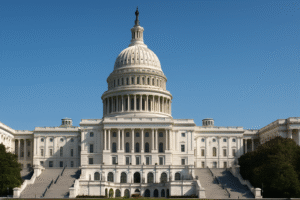Duration & Credit Pulse
Executive Summary
Bottom Line: The government shutdown October 2025 created unprecedented market conditions as Treasury yields fell 8-9 basis points across the curve while credit markets experienced violent repricing—high yield spreads ballooned 40bp amid a 30% VIX surge to 21.66. The data blackout forced the Federal Reserve to signal continued easing without visibility into September employment or inflation figures, with FOMC minutes revealing rising "downside risks to employment" as the dominant policy concern. Friday's trade war escalation, with threats of 100% tariffs on Chinese imports, triggered the sharpest risk-off rotation in six months, exposing dangerous complacency in credit markets trading at 32nd percentile spreads.
Duration Dashboard – Government Shutdown Drives Treasury Rally
| Maturity | October 5, 2025 | October 12, 2025 | Weekly Δ | 5-Year Percentile |
|---|---|---|---|---|
| 2‑Year | 3.58% | 3.50% | -8 bp | 36th %ile (middle range) |
| 5‑Year | 3.72% | 3.63% | -9 bp | 43rd %ile (middle range) |
| 10‑Year | 4.12% | 4.03% | -9 bp | 60th %ile (middle range) |
| 30‑Year | 4.71% | 4.62% | -9 bp | 80th %ile (elevated) |
Flight to Quality Flattens Curve
Curve Analysis: Treasury markets exhibited classic flight-to-quality dynamics as the government shutdown's data blackout combined with trade war fears to drive uniform 8-9 basis point declines across the curve. The parallel shift maintained the 2s30s spread near 112 basis points, suggesting balanced duration demand rather than targeted Fed policy trades. The 30-year's position at the 80th percentile even after the rally highlights persistent term premium concerns about fiscal sustainability, while shorter maturities remain comfortably in middle-range territory reflecting confidence in near-term Fed easing.
The government shutdown that began October 1 created an unprecedented information vacuum that paradoxically strengthened Treasury demand. With the Bureau of Labor Statistics unable to release September payrolls on October 3 and all major economic indicators suspended, investors defaulted to safety positioning. The 10-year yield's decline from 4.12% to 4.03% materialized despite—or perhaps because of—the absence of confirming economic weakness, as uncertainty itself became the dominant market driver. The 2-year yield fell 8 basis points while longer maturities declined 9 basis points, reflecting balanced flight-to-quality flows across the curve.
Credit Pulse – Historic Complacency Meets Violent Reality
| Metric | October 5, 2025 | October 12, 2025 | Weekly Δ | 5-Year Percentile |
|---|---|---|---|---|
| IG OAS | 70 bp | 78 bp | +8 bp | 32nd %ile (middle range) |
| HY OAS | 256 bp | 296 bp | +40 bp | 32nd %ile (middle range) |
| VIX Index | 16.65 | 21.66 | +5.01 | 72nd %ile (middle range) |
Credit markets entered the week at dangerously compressed levels—investment grade at just 70 basis points marked the tightest spreads since 2005—leaving zero margin for error when Friday's trade war escalation struck. The high yield market's 40 basis point widening from 256bp to 296bp represented the sharpest single-week deterioration since April's tariff crisis, yet spreads remain at just the 32nd percentile of their 5-year range, suggesting far more pain ahead if recession risks materialize. The VIX explosion from 16.65 to 21.66—a 30% surge—captured the violence of sentiment shift when President Trump threatened 100% tariffs on all Chinese imports.
Primary issuance froze as volatility spiked: Weekly investment-grade supply collapsed to just $15-25 billion, down 88% from September's record-setting $56.5 billion weekly average. The dramatic pullback from September's monthly record of $226 billion—which had pushed year-to-date issuance to $1.74 trillion—reflected treasurers' unwillingness to price new deals into deteriorating conditions. At least 3-5 transactions were reportedly pulled from the calendar Friday, with syndicate desks reporting negligible investor interest at spreads that seemed attractive just days earlier. Secondary market liquidity remained orderly with bid-ask spreads widening modestly to 3-4 basis points in investment grade and 8-10 basis points in high yield, though dealers noted dramatically reduced risk appetite for inventory positions.
Private Credit Stress Monitor – Cockroaches Emerging
Beneath the relatively orderly public credit markets, private credit stress signals multiplied during the week with two high-profile bankruptcies exposing deteriorating underwriting standards. First Brands Group, an auto parts distributor backed by multiple private lenders, filed for Chapter 11 protection citing liquidity constraints and covenant breaches. More troubling was Tricolor Holdings, a subprime auto lender that collapsed amid allegations of pledging the same collateral to multiple lenders—a fraud that evokes memories of 2008's documentation crisis.
Weekly Fund Flow Tracker – Sentiment Reverses Violently
| Asset Class | Week Ending Oct 8 | Week Ending Oct 15* | Change | Signal |
|---|---|---|---|---|
| Total Bond Funds | +$10.54B | -$333M | -$10.87B | Risk-Off |
| Taxable Bonds | +$7.5B | -$1.25B | -$8.75B | Capitulation |
| High Yield | +$450M | -$380M | -$830M | Flight to Quality |
| Money Markets | +$19.84B | +$28.2B | +$8.36B | Cash Hoarding |
*Preliminary data including October 10-12 flows
The fund flow reversal captured the week's sentiment shift with surgical precision. Through Wednesday, robust inflows of $10.54 billion suggested investors were buying the dip in bonds amid falling yields. Friday's trade war escalation triggered an immediate reversal—the $10.87 billion swing from inflows to outflows marked the sharpest sentiment reversal since March 2023's banking crisis. Money market funds absorbed $28.2 billion for the week ending October 15, accelerating from the prior week's $19.84 billion as institutional investors prioritized capital preservation over yield.
US Macroeconomic Assessment – Navigating Without Instruments
The government shutdown October 2025 transformed the week of October 5-12 into an economic Rorschach test where market participants saw what they feared most. The complete suspension of Bureau of Labor Statistics data meant September's employment report—arguably the Fed's most critical input—never materialized. Private estimates suggested jobless claims around 235,000, but without official validation, these projections carried little weight. The revelation that March 2025 payrolls were revised down by 900,000 jobs added to the sense that labor market deterioration had been understated for months.
Fed communication fills the data void: Wednesday's FOMC minutes from the September 16-17 meeting became the week's pivotal event, revealing that "most" officials favored continued easing with explicit acknowledgment that "downside risks to employment have risen." The 11-1 vote, with Stephen Miran dissenting for a larger cut, suggested growing urgency about supporting the labor market even as core PCE inflation remained stuck at 2.9%. The Committee's willingness to look through above-target inflation while prioritizing employment marked a decisive shift in the reaction function that bond markets immediately embraced.
ISM Services hits contraction territory: The few data points that did emerge painted a concerning picture—the ISM Services PMI touching 50.0 marked the first brush with contraction since 2010, suggesting the shutdown's economic drag was compounding underlying weakness. Without retail sales, industrial production, or housing data to provide cross-verification, this single indicator gained outsized importance as evidence that the longest economic expansion was finally fracturing.
Trade war escalation shatters fragile calm: Friday's bombshell—threats of 100% tariffs on all Chinese imports effective November 1—transformed market dynamics instantly. Coming just one day after China announced export controls on rare earth metals, the tit-for-tat escalation evoked memories of April 2025's market chaos when similar threats briefly pushed VIX above 65. The dollar index's narrow 97.95-98.94 weekly range masked violent intraday swings as currency traders struggled to price the inflationary impact of potential tariffs against the growth destruction they would cause.
Dollar weakness and gold surge signal deep uncertainty: The greenback's 12.5% year-to-date decline accelerated during the shutdown, paradoxically making Treasuries more attractive to foreign buyers even as fiscal dysfunction worsened. Gold's surge toward $4,000 per ounce—marking its eighth consecutive weekly gain—underscored the global scramble for assets immune to both currency debasement and political volatility. This dollar weakness despite haven flows revealed market fears that America's fiscal trajectory, combined with potential trade wars, could undermine the currency's reserve status. Japanese investors remained particularly active in Treasury markets, with the yen's weakness providing additional incentive to capture 4%+ yields that dwarf JGB returns.
Federal Reserve Policy Outlook – Easing Into the Unknown
The Federal Reserve faces an unprecedented challenge: calibrating monetary policy without the economic dashboard that typically guides decisions. Market pricing shifted decisively toward continued easing, with fed funds futures showing 96% probability of a 25 basis point cut at the October 28-29 FOMC meeting, taking rates to 3.75-4.00%. The forward curve anticipates at least two additional cuts by year-end, reaching 3.50-3.75% terminal rate by mid-2026.
The minutes' revelation that officials see labor market risks dominating inflation concerns provides intellectual cover for aggressive easing even without confirming data. References to reserves at $3.0 trillion and approaching the end of quantitative tightening "in coming months" added another dovish dimension, signaling the Fed's multi-pronged approach to ensuring financial conditions remain accommodative. Yet the dissent for a larger cut hints at internal debates about whether quarter-point moves are sufficient given accumulating downside risks.
Week Ahead: Data Returns as Shutdown Drags On
- Powell Speech (October 14): Chair Powell addresses National Association for Business Economics, first opportunity to clarify Fed thinking post-minutes. Markets desperate for forward guidance given data vacuum.
- Bank Earnings Begin (October 15): Major banks report Q3 results, providing first real-time window into credit conditions, loan loss provisioning, and commercial real estate exposure absent official economic data.
- China Trade Retaliation Risk: Beijing's response to 100% tariff threat remains unknown. Any escalation in export controls or Treasury selling could amplify Friday's risk-off moves.
Fixed Income Positioning – Fade the Extremes
Tactical opportunities emerge from violent repricing: Investment grade corporates at 78bp now screen cheap versus Treasuries given the Fed's easing bias, but remain expensive versus likely recession scenarios that typically drive spreads to 150-200bp. Focus on defensive sectors—utilities, healthcare REITs, and consumer staples—that traded down sympathetically with cyclicals. Avoid airlines, retail, and any company with >20% China revenue exposure.
High yield offers selective value in specific cohorts: The 40bp widening created entry points in BB-rated energy credits trading at 250-300bp despite oil at $60+ and manageable debt maturities. However, avoid CCC-rated retail and consumer discretionary names where 500bp+ spreads still don't compensate for tariff-driven margin compression. Private credit refugees rated B/B- facing 2025-2026 maturities should trade 100-150bp wider given refinancing challenges.
Duration play crystallizes with 10-year at 4.03%: Establish 70% of target duration exposure at current 4.03% yield, saving ammunition for potential backup to 4.20-4.30% if China retaliates. The 2s10s curve at 53bp offers limited steepening value; better risk-reward exists in 5s30s at 99bp targeting 130-140bp if recession materializes. Avoid Treasury auctions until shutdown resolution provides clarity on fiscal trajectory. Consider TIPS at 1.80% real yields as tariff hedge, though breakevens at 2.23% already price significant inflation risk.
The week's defining lesson: When credit markets trade at historic tights (32nd percentile), any shock triggers outsized repricing. Friday's 40bp high yield widening from an already-tight 256bp base demonstrates the violence of unwinds when positioning is uniformly one-sided. The $10.87 billion fund flow reversal—from massive inflows to outflows in 48 hours—reveals how quickly "buy the dip" morphs into "sell everything" when uncertainty spikes. Private credit's 5.5% default rate versus public market's 32nd percentile spreads represents the cycle's greatest valuation disconnect. Those maintaining 30% cash and 50% Treasuries entering the week captured alpha through redeployment opportunity; those fully invested in tight credit sectors face 3-6 months of underperformance. As October's data vacuum extends into November, one certainty emerges: spreads at the 32nd percentile cannot survive contact with reality when that reality includes government dysfunction, trade wars, and accelerating private market defaults.
Frequently Asked Questions
Why did Treasury yields fall during the government shutdown October 2025?
Treasury yields dropped 8-9 basis points across the curve as investors sought safe-haven assets amid unprecedented uncertainty. The data blackout eliminated normal economic signals, forcing traders to default to defensive positioning while the Fed signaled continued rate cuts despite missing inflation and employment data.
How much did credit spreads widen during the October 2025 trade war escalation?
High-yield spreads widened 40 basis points from 256bp to 296bp following Friday's threat of 100% China tariffs, marking the sharpest weekly deterioration since April. Investment-grade spreads widened more modestly by 8bp to 78bp, though both remain at just the 32nd percentile historically.
What is the Fed's rate cut outlook without economic data?
Markets price 96% probability of a 25bp cut at the October 28-29 FOMC meeting despite the data vacuum. The September minutes revealed "downside risks to employment have risen," providing justification for continued easing even without September's jobs report or CPI data.
When will government shutdown economic data be released?
The Bureau of Labor Statistics suspended all releases indefinitely, with September CPI potentially delayed until October 24. Critical reports including September payrolls, retail sales, and industrial production have no scheduled release dates until the shutdown ends, creating an extended period of economic uncertainty.
Key Articles of the Week
-
10-year Treasury yield is flat as Fed minutes show indecision over future rate cutsCNBCOctober 8, 2025Read Article
-
FOMC Minutes, September 16-17, 2025Federal ReserveOctober 8, 2025Read Article
-
Trump announces new 100 percent tariffs on China, may cancel Xi meetingThe Washington PostOctober 10, 2025Read Article
-
CPI inflation report will be released by Labor Department, while other data is delayedCNBCOctober 10, 2025Read Article
-
Treasury Yields Snapshot: October 10, 2025Advisor PerspectivesOctober 10, 2025Read Article
-
US Government Shutdown: What's the Impact?J.P. MorganOctober 10, 2025Read Article
-
Services PMI at 50%; September 2025 ISM Services PMI ReportInstitute for Supply ManagementOctober 5, 2025Read Article







